标签:cPage style blog http java color
// the parent constructor function Parent(name) { this.name = name || ‘Adam‘; } // adding functionality to the prototype Parent.prototype.say = function () { return this.name; }; // empty child constructor function Child(name) {} inherit(Child, Parent);
A method say() added to the parent constructor’s prototype, and a call to a function called inherit() that takes care of the inheritance. The inherit() function is not provided by the language, so you have to implement it yourself.
Classical Pattern #1—The Default Pattern
Create an object using the Parent() constructor and assign this object to the Child()’s prototype.
function inherit(C, P) { C.prototype = new P(); } var kid = new Child(); kid.say(); // "Adam"
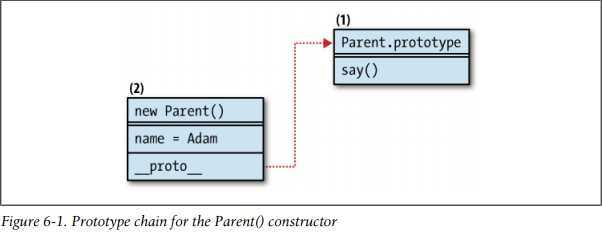
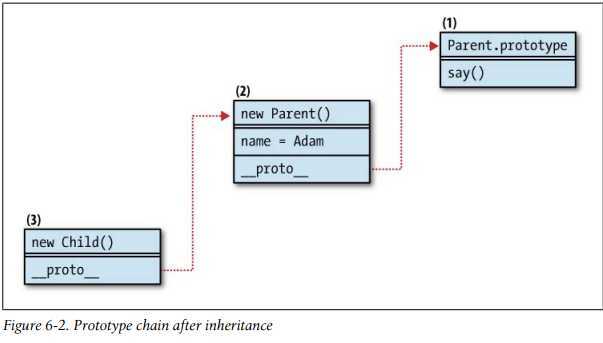
Note: reusable members should be added to the prototype.
Classical Pattern #2 -- Rent-a-Constructor
Passing arguments from the child to the parent.
function Child(a, c, b, d) { Parent.apply(this, arguments); } // a parent constructor function Article() { this.tags = [‘js‘, ‘css‘]; } var article = new Article(); // a blog post inherits from an article object // via the classical pattern #1 function BlogPost() {} BlogPost.prototype = article; var blog = new BlogPost(); // note that above you didn‘t need `new Article()` // because you already had an instance available // a static page inherits from article // via the rented constructor pattern function StaticPage() { Article.call(this); } var page = new StaticPage(); alert(article.hasOwnProperty(‘tags‘)); // true alert(blog.hasOwnProperty(‘tags‘)); // false alert(page.hasOwnProperty(‘tags‘)); // true
The inheritance was a one-off action that copied parent’s own properties as child’s own properties and that was about it; no __proto__ links were kept.
// the parent constructor function Parent(name) { this.name = name || ‘Adam‘; } // adding functionality to the prototype Parent.prototype.say = function () { return this.name; }; // child constructor function Child(name) { Parent.apply(this, arguments); } function showMsg(msg) { $(‘#msg‘).append(msg).append(‘<br/>‘); } $(function () { var kid = new Child("Patrick"); showMsg(kid.name); // "Patrick" showMsg(typeof kid.say); // "undefined" });
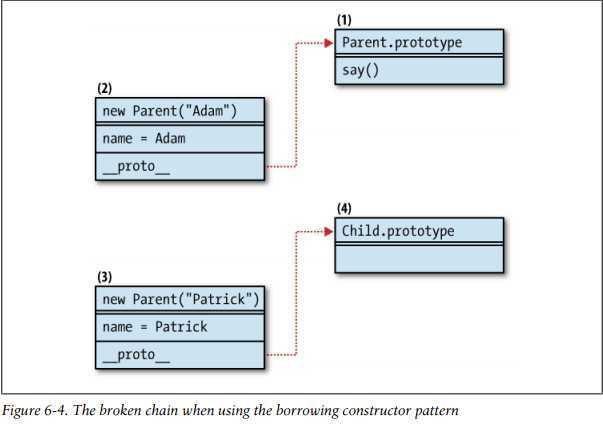
Implement multiple inheritance simply by borrowing from more than one constructor
function Cat() { this.legs = 4; this.say = function () { return "meaowww"; } } function Bird() { this.wings = 2; this.fly = true; } function CatWings() { Cat.apply(this); Bird.apply(this); } var jane = new CatWings(); console.dir(jane);

Pros: Get true copies of the parent‘s own members and there‘s no risk that a child can accidentally overwrite a parent‘s property.
Cons: Nothing from the prototype gets inherited.
Classical Pattern #3—Rent and Set Prototype
function Child(a, c, b, d) { Parent.apply(this, arguments); } Child.prototype = new Parent();
The benefit is that the result objects get copies of the parent’s own members and references to the parent’s reusable functionality (implemented as members of the prototype). The child can also pass any arguments to the parent constructor. This behavior is probably the closest to what you’d expect in Java; you inherit everything there is in the parent, and at the same time it’s safe to modify own properties without the risk of modifying the parent.
A drawback is that the parent constructor is called twice, so it could be inefficient. At the end, the own properties (such as name in our case) get inherited twice.
// the parent constructor function Parent(name) { this.name = name || ‘Adam‘; } // adding functionality to the prototype Parent.prototype.say = function () { return this.name; }; // child constructor function Child(name) { Parent.apply(this, arguments); } Child.prototype = new Parent(); function showMsg(msg) { $(‘#msg‘).append(msg).append(‘<br/>‘); } var kid = new Child("Patrick"); kid.name; // "Patrick" kid.say(); // "Patrick" delete kid.name; kid.say(); // "Adam"
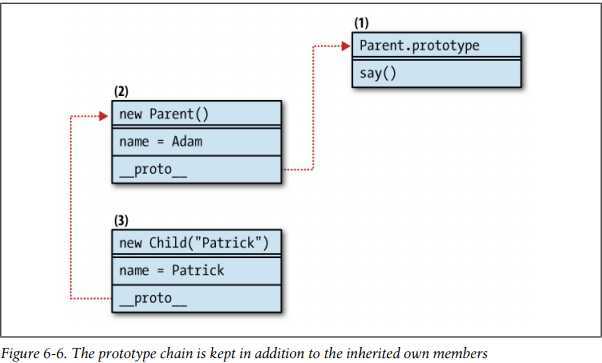
Classical Pattern #4—Share the Prototype
This gives you short and fast prototype chain lookups because all objects actually share the same prototype.
function inherit(C, P) { C.prototype = P.prototype; }
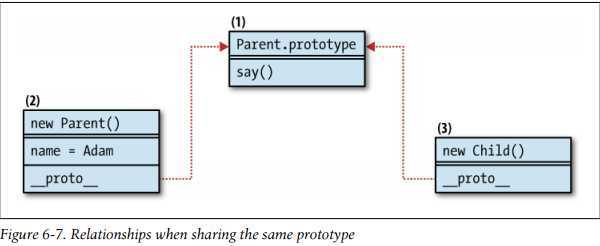
Drawback
if one child or grandchild somewhere down the inheritance chain modifies the prototype, it affects all parents and grandparents.
Classical Pattern #5—A Temporary Constructor
An empty function F(), which serves as a proxy between the child and the parent. F()’s prototype property points to the prototype of the parent. The prototype of the child is an instance of the blank function:
function inherit(C, P) { var F = function () {}; F.prototype = P.prototype; C.prototype = new F(); }

In this pattern, any members that the parent constructor adds to this are not inherited.
The property is called uber because “super” is a reserved word and “superclass” may
lead the unsuspecting developer down the path of thinking that JavaScript has classes.
Here’s an improved implementation of this classical pattern:
function inherit(C, P) { var F = function () {}; F.prototype = P.prototype; C.prototype = new F(); C.uber = P.prototype; }
If you don’t reset the pointer to the constructor, then all children objects will report that Parent() was their constructor, which is not useful.
// parent, child, inheritance function Parent() {} function Child() {} inherit(Child, Parent); // testing the waters var kid = new Child(); kid.constructor.name; // "Parent" kid.constructor === Parent; // true function inherit(C, P) { var F = function () {}; F.prototype = P.prototype; C.prototype = new F(); C.uber = P.prototype; C.prototype.constructor = C; }
Create temporary (proxy) constructor once and only change its prototype. You can use an immediate function and store the proxy function in its closure:
var inherit = (function () { // This will only be executed once which means only one function object is created for every inheritance. var F = function () {}; return function (C, P) { F.prototype = P.prototype; // F.prototype.constructor is pointed to Parent. C.prototype = new F(); C.uber = P.prototype; C.prototype.constructor = C; } }());
References:
JavaScript Patterns - by Stoyan Stefanov (O`Reilly)
JavaScript Patterns 6.2 Expected Outcome When Using Classical Inheritance,布布扣,bubuko.com
JavaScript Patterns 6.2 Expected Outcome When Using Classical Inheritance
标签:cPage style blog http java color
原文地址:http://www.cnblogs.com/haokaibo/p/Expected-Outcome-When-Using-Classical-Inheritance.html